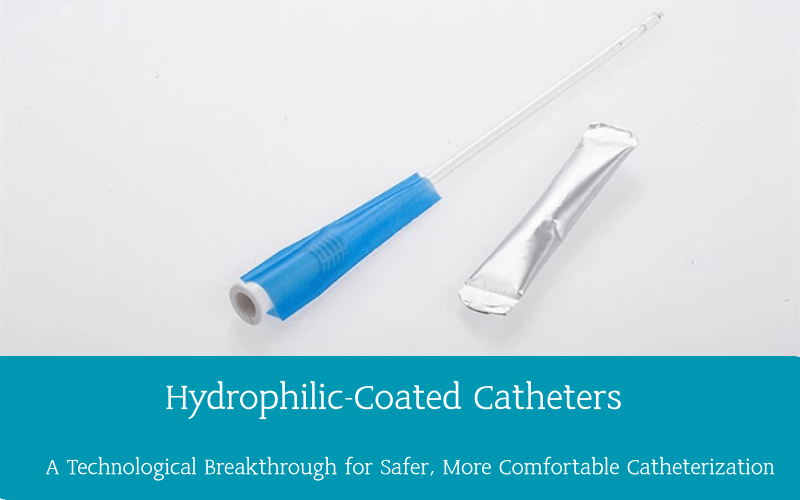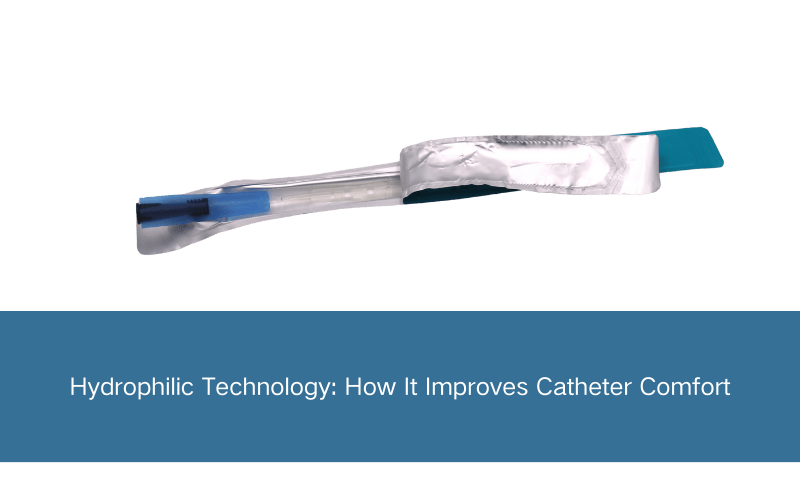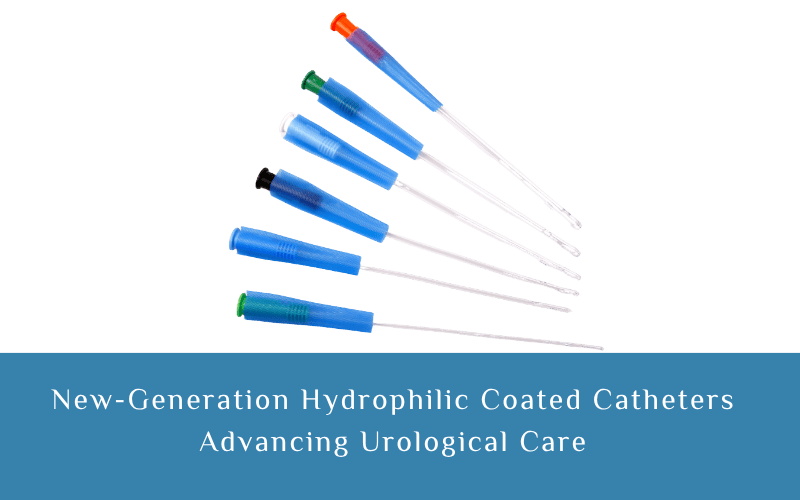During clinical catheterization, patients often experience discomfort or even pain. Traditional catheters, with their higher surface friction, can cause urethral trauma and increase the risk of urinary tract infections. This not only affects patient experience but also adds to the workload of healthcare staff and hospital management. To address these challenges, hydrophilic-coated catheters have emerged as a major innovation in medical consumables, offering patients a safer and more comfortable catheterization experience. What Are Hydrophilic Coatings? Hydrophilic coatings are specialized functional layers that rapidly absorb water and form a smooth lubricating film on the catheter surface. This water layer significantly reduces friction between the catheter and the urethra, enhancing patient comfort while inhibiting bacterial adhesion and reducing the risk of urinary tract infections. In terms of production, hydrophilic coatings are typically applied through chemical grafting, physical adsorption, or composite coating technologies. These methods ensure that the coating remains stable, durable, and safe for clinical use. Key benefits include: Reduced friction: Ensures smoother catheterization, minimizing urethral mucosa damage. Enhanced lubrication: Ready-to-use catheters that require no additional lubrication. Bacterial adhesion prevention: Lowers infection risks and improves clinical safety. Applications and Use Scenarios Hydrophilic coated catheters are suitable for a wide range of clinical catheterization needs, including intermittent or long-term catheterization for both male and female patients. Common application scenarios include: Hospitals and rehabilitation centers Nursing homes and home care Postoperative or recovery-phase catheterization Compared with traditional catheters, hydrophilic-coated catheters are ready-to-use, reducing the steps required for healthcare staff and lowering operational burden, while significantly improving patient comfort and satisfaction. Advantages: Hydrophilic Coated vs Non Coated Catheters As the table shows, hydrophilic-coated catheters offer clear advantages in patient comfort, ease of use, and clinical safety. Scientific Breakthrough and Technical Strength Our R&D team has developed stable, durable, and environmentally safe hydrophilic-coated catheters through years of material innovation. Clinical studies show that, compared to traditional catheters, patients using hydrophilic-coated catheters report a 60% reduction in discomfort, along with a significant decrease in urinary tract infection rates. Additionally, nursing operations become more efficient, benefiting both hospitals and home care settings. This technological breakthrough demonstrates our professional expertise in medical device development and reflects our commitment to improving patient quality of life through innovation. Conclusion Hydrophilic-coated catheters reduce friction, enhance comfort, and inhibit bacterial adhesion, providing patients with a safer and more comfortable experience. At the same time, they offer healthcare staff a more convenient and efficient operation. Choosing hydrophilic-coated catheters means selecting high-quality medical products while ensuring patient health and improving caregiving efficiency.
View More +-
10 Dec 2025
Urinary catheterization is a vital tool for individuals who have difficulty emptying their bladder naturally. Among the different catheter types, hydrophilic catheters stand out for their enhanced comfort, ease of use, and reduced risk of urethral trauma. Hydrophilic technology has transformed intermittent catheterization, making it more manageable for patients at home, in clinical settings, and even during travel. What Is Hydrophilic Technology? Hydrophilic catheters feature a special coating that becomes slippery when activated with water. This coating forms a thin lubricating layer on the catheter's surface, reducing friction during insertion and withdrawal. Unlike standard PVC catheters, which require manual lubrication, hydrophilic catheters are either pre-lubricated or pre-coated, providing smooth, low-resistance catheterization with minimal preparation. This design helps protect the urethra from irritation or trauma, making the process more comfortable and safer. Comfort Advantages One of the main benefits of hydrophilic catheters is increased comfort. By minimizing friction, these catheters reduce the risk of urethral microtrauma, bleeding, and discomfort associated with repeated catheterization. Patients experience smoother insertion and removal, which can lower anxiety and increase confidence in self-catheterization. For many users, this technology promotes independence and enhances quality of life, particularly for those requiring long-term intermittent catheterization. Practical Tips for Use To maximize comfort and safety, proper technique is essential: Activate the coating: Immerse the catheter in water or follow the manufacturer's instructions to ensure full lubrication. Maintain correct positioning: Insert the catheter slowly and gently, following the natural curvature of the urethra. Avoid forcing the catheter if resistance occurs. Lubricant use: Most hydrophilic catheters do not require additional lubricant, though a small amount can be applied if desired for extra comfort. Real-Life Scenarios Hydrophilic catheters are convenient for everyday life. They are portable and discreet, making them suitable for travel or public use. For nighttime catheterization or elderly patients with limited mobility, the smooth surface simplifies handling and reduces discomfort. Both male and female users benefit from hydrophilic catheters, although insertion techniques may vary slightly based on anatomy. Common Questions and Misconceptions Can they be reused? Most hydrophilic catheters are single-use to ensure hygiene and safety. Why might they feel less slippery sometimes? This can occur if the coating is not fully activated or the catheter has dried before use. Does storage affect performance? Yes, improper storage, such as exposure to extreme temperatures or prolonged dryness, can reduce slipperiness. Always follow the manufacturer's instructions. BEVER Medical Product Features BEVER Medical offers hydrophilic catheters with advanced surface technology, ergonomic packaging, and smooth, consistent coatings. Their products are designed for safe, comfortable, and effective catheterization at home or in clinical settings. Features such as pre-lubricated surfaces, easy-open packaging, and high-quality materials help users gain confidence and maintain independence. Conclusion and Safety Reminder Hydrophilic technology significantly improves the comfort and safety of intermittent catheterization. By reducing friction and urethral trauma, these catheters help patients manage bladder care independently and confidently. Proper technique and adherence to medical guidance remain essential. If pain, bleeding, or difficulties occur, consult a healthcare professional promptly. Disclaimer This article is intended for general educational purposes and does not replace professional medical advice. Always consult a qualified healthcare provider before selecting or using a urinary catheter. Individual needs may vary, and proper technique and product selection are essential for safe and effective catheterization.
View More + -
17 Nov 2025
Hydrophilic Catheters: Reducing Friction and Enhancing Comfort Understanding Hydrophilic Catheters A hydrophilic catheter is designed with a surface that binds water molecules, forming a lubricious layer that reduces friction during insertion and withdrawal. This low-friction surface is particularly important for patients performing intermittent catheterization, as it helps minimize urethral microtrauma, hematuria, and discomfort. Numerous clinical studies indicate that hydrophilic catheters improve patient adherence, particularly in home-care settings where users perform multiple daily catheterizations. Clinical Advantages Reduced Urethral Trauma: The gel-like surface lowers friction, preventing tissue damage and bleeding. Enhanced Comfort: Smooth insertion and withdrawal improve patient experience. Better Compliance: Less pain and irritation encourages regular use, supporting recommended catheterization schedules. Versatility: Suitable for both hospital environments and at-home use. Hydrophilic Coated Catheters: Next-Generation Design Advanced Coating Technology The hydrophilic coated catheter represents a significant evolution from standard hydrophilic catheters. Unlike traditional catheters that require manual lubrication, coated catheters feature a permanently bonded hydrophilic layer that activates instantly upon contact with sterile water. This provides consistent lubrication along the catheter surface, reducing the risk of friction-related injury and minimizing handling, which may contribute to lower contamination risk. User-Centric Design Features Modern hydrophilic coated catheters integrate multiple design innovations aimed at improving both safety and usability: No-touch Handling Sleeves: Reduce contamination during insertion. Flexible, Kink-Resistant Shafts: Ensure smooth fluid flow and durability. Tapered, Atraumatic Tips: Facilitate easier insertion and reduce urethral irritation. Integrated Sterile Water Sachets: Allow rapid and reliable activation of the hydrophilic coating. Clinical evidence suggests that these features can reduce urethral trauma and improve patient comfort, while supporting adherence in patients who require frequent catheterization. Some studies also indicate a potential reduction in catheter-associated urinary tract infections, although results may vary depending on patient population and care conditions. Choosing the Right Catheter for Patients Hydrophilic Catheter Selection A standard hydrophilic catheter is often suitable for patients with intermittent catheterization needs of lower frequency. Its smooth surface and ease of use make it ideal for patients already familiar with self-catheterization techniques. Hydrophilic Coated Catheter Selection The hydrophilic coated catheter is particularly recommended for patients requiring high-frequency or long-term catheterization. Its pre-hydrated coating and ergonomic design reduce handling and contamination risk, offering safer and more convenient use—especially in home-care scenarios where patients or caregivers manage catheterization independently. Clinical Impact and Patient Outcomes Improving Patient Comfort Next-generation hydrophilic coated catheters significantly enhance patient comfort. By minimizing friction and urethral trauma, patients experience less pain and irritation. This improvement supports adherence to recommended catheterization schedules, which is critical for maintaining urinary health and preventing complications such as retention or trauma-related hematuria. Reducing Complications Hydrophilic coated catheters help lower the incidence of common complications: Hematuria due to urethral microtrauma Discomfort or pain during catheter insertion and removal Potential reduction in infection risk with proper handling While some studies report lower rates of urinary tract infections, evidence varies; careful hygiene and proper technique remain essential. Supporting Healthcare Providers For healthcare professionals, these catheters simplify procedural workflow, reduce the need for repeated interventions, and enhance patient safety. They also decrease caregiver burden, enabling more efficient and safer home-care management. Future Trends in Hydrophilic Catheter Technology Emerging Innovations The field of hydrophilic catheter design continues to evolve, driven by materials science and patient-centered engineering. Current trends include: Antimicrobial Coatings: To potentially reduce infection risk and improve safety. Biocompatible and Eco-Friendly Materials: Enhancing safety and sustainability. Smart Catheter Technologies: Monitoring usage patterns and patient adherence in real time. Clinical Implications These innovations aim to improve the standard of care for patients requiring intermittent catheterization. By enhancing comfort, safety, and efficiency, next-generation hydrophilic coated catheters align with the evolving needs of both patients and healthcare providers, while supporting more consistent and reliable care practices. Conclusion The evolution of hydrophilic catheters and hydrophilic coated catheters represents a major advancement in urological care. Modern designs combine low-friction surfaces, user-friendly handling, and innovative coatings to enhance patient comfort, minimize complications, and improve procedural efficiency. For healthcare providers and institutions, these devices demonstrate how thoughtful design and evidence-based innovation can transform everyday catheterization practices.
View More + -
03 Nov 2025
Going home with a urinary catheter can feel intimidating at first. For many, the idea of managing a medical device at home raises questions about hygiene, comfort, and safety. However, with proper understanding, the right equipment, and consistent care routines, living with a catheter at home is entirely manageable, and it can even support recovery and independence. Understanding Urinary Catheters A urinary catheter is a thin, sterile tube inserted into the bladder to allow urine to drain when natural urination is not possible or safe. Catheters come in several types: Indwelling (Foley) catheters: These remain in place for several days or weeks, secured by a small balloon inside the bladder. Urine flows continuously into a drainage bag. Suprapubic catheters: Inserted through a small abdominal opening, these offer an alternative route when urethral insertion is not suitable.· Intermittent catheters: Single-use devices that are inserted only when the bladder needs emptying and then removed.· Female external catheters: Non-invasive options that fit outside the body, often used for short-term management. Knowing which type you have is crucial for proper care and preventing complications. Preparing for Home Care Before leaving the hospital, ensure you or your caregiver understand how to manage the catheter. Key points include: Hand hygiene: Always wash hands thoroughly before and after touching the catheter, tubing, or drainage bag. This is the most important step to prevent infection. Insertion site care: Clean the area around the catheter daily with mild soap and water. Female patients should clean from front to back to reduce bacterial contamination. Bag and tubing management: The drainage bag should hang below bladder level at all times to allow urine to drain properly. Ensure tubing is free from kinks or pressure, and empty the bag when it is about two-thirds full. Choosing the Right Equipment High-quality catheter equipment makes home care easier and safer. Pre-lubricated, hydrophilic catheters reduce friction during insertion and minimize discomfort, especially for self-catheterization. Closed systems, which include an integrated drainage bag, limit handling of urine and reduce infection risk. Some kits include a catheter, sterile water for lubrication, and a collection bag, providing everything needed for safe home use. For female patients, external or specialized intermittent catheters can offer comfort and make daily management simpler. Selecting equipment appropriate for your needs — considering factors like mobility and dexterity — is essential to maintaining independence at home. Daily Care and Hygiene Maintaining hygiene and following proper routines are essential: Hand washing: Always before and after touching any part of the catheter system. Skin care: Clean the area around the catheter gently each day. Avoid harsh or scented soaps. Bag care:Empty the drainage bag regularly, usually when it reaches two-thirds capacity. Ensure tubing is not compressed or kinked. Hydration: Drink adequate fluids (unless restricted by your doctor) to keep urine flowing and reduce infection risk. For intermittent catheters, avoid touching the tip or insertion end. For indwelling catheters, keep the balloon and tubing stable, avoid twisting, and ensure leg straps are snug but not tight. Monitoring for Problems Even with careful care, it is important to be aware of warning signs: Little or no urine output despite feeling the bladder is full Cloudy, foul-smelling, or bloody urine Pain, swelling, or redness around the catheter site Fever, chills, or general malais Catheter displacement or blockage Contact a healthcare professional immediately if any of these occur. Early intervention can prevent serious complications such as urinary tract infections or bladder injury. Tips for Comfort and Independence Managing a catheter at home doesn't mean limiting your lifestyle. Consider these tips: Keep a log: Track when you empty the bag, change tubing, or notice any issues. Mobility: Ensure tubing has enough slack for walking, sitting, and daily activities. Avoid sharp bends or pressure that could block flow. Supplies:Keep extra drainage bags, tubing, and catheters at home for emergencies. Travel: Plan for restroom access, carry spare supplies, and maintain hygiene when away from home. Confidence grows with experience. Many patients report that after a few days or weeks, home catheter management becomes a routine part of daily life. Psychological Considerations It is normal to feel anxious or self-conscious when first using a catheter at home. Patience, structured routines, and support from family or caregivers help reduce stress. Open communication with healthcare providers can clarify uncertainties and reinforce confidence in self-care. Recommended Catheter Solutions from BEVER Medical For patients and caregivers seeking reliable and comfortable options, BEVER Medical offers several specialized products: Pediatric Closed System Intermittent Catheter Kit Designed for children, this all-in-one kit helps kids, parents, or caregivers perform intermittent catheterization conveniently and safely. The closed system reduces handling and contamination risk, making the process easier for young users. Male Hydrophilic Coated Intermittent Catheter Featuring a hydrophilic coating, sterile water sachet, and no-touch handling sleeve, this catheter allows preparation, use, and disposal without direct contact, enhancing hygiene and comfort. Female Intermittent Catheter Made from DEHP-free PVC, it features polished eyelets and smooth edges to minimize irritation. A colored funnel provides a secure grip while reducing unnecessary contact, and lubricant jelly can be used to facilitate insertion, ensuring a comfortable and safe catheterization experience. These products demonstrate how modern catheter design can support independence, hygiene, and comfort for patients of all ages and genders, making home catheter care simpler and safer. Final Thoughts With the right knowledge, equipment, and routines, living with a urinary catheter at home is manageable and safe. Understanding your catheter type, maintaining hygiene, monitoring for problems, and using high-quality devices like those from BEVER Medical can help you maintain independence, confidence, and a normal lifestyle. Remember, your healthcare team is your partner. Stay informed, stay proactive, and with consistent care, a home urinary catheter can become a routine tool for recovery and long-term well-being rather than a source of anxiety.
View More + -
27 Oct 2025
Effective urine management in the Intensive Care Unit (ICU) is a critical component of patient care. ICU patients often require continuous monitoring, and improper urine management can lead to complications such as urinary tract infections, catheter blockages, or inaccurate fluid balance records. Hospitals and healthcare providers must implement comprehensive urine management strategies, combining best practices with high-quality medical devices. This guide explores ICU urine management solutions, emphasizing patient safety, efficiency, and the role of intermittent catheterization in patient-centered care. 1. Importance of ICU Urine Management ICU patients are often critically ill and may require specialized urinary monitoring or intermittent catheterization (IC). Effective urine management has several key objectives: Preventing Urinary Tract Infections (UTIs): ICU patients are at higher risk of catheter-associated urinary tract infections (CAUTIs). Proper catheter selection, sterile insertion, and regular maintenance are essential to reduce infection rates. Accurate Fluid Balance Monitoring: Precise urine measurement helps clinicians monitor kidney function, detect fluid imbalances, and adjust treatment plans. Enhancing Patient Comfort and Safety: High-quality catheters, including hydrophilic intermittent catheters, reduce discomfort, prevent trauma, and maintain consistent urine drainage. Supporting Workflow Efficiency: Automated or smart urine management systems can reduce nursing workload, minimize errors, and provide real-time data for better clinical decision-making. 2. Best Practices for ICU Urine Management 1)Selecting the Right Catheter ICU patients may require intermittent catheterization or other specialized catheters. Silicone or medical-grade PVC catheters are commonly used due to their durability and flexibility. Hydrophilic catheters provide pre-lubrication, reducing friction during insertion and enhancing patient comfort. Hospitals can partner with manufacturers to obtain catheters tailored to ICU needs, including specific lengths, diameters, and features suitable for IC. 2)Sterile Insertion and Maintenance Follow strict aseptic techniques during catheter insertion. Gloves, masks, and sterile drapes should be used. Regular cleaning of the catheter insertion site prevents bacterial growth and reduces infection risk. Secure the catheter or collection system to avoid accidental dislodgement, which can compromise patient safety. 3)Urine Monitoring and Recording Record urine output, color, and odor at regular intervals to detect early signs of complications. Smart ICU urine management systems can automate these measurements, providing alerts for unusual volumes or changes in urine characteristics. 4)Device Management and Catheter Replacement Replace catheters according to clinical guidelines and product instructions, particularly for repeated intermittent catheterization. Proper disposal and adherence to sterile techniques are essential to prevent contamination. 3. Educational Significance Proper ICU urine management and intermittent catheterization are not only clinical tasks but also educational opportunities for healthcare providers and caregivers. Training on IC technique, hygiene, and monitoring ensures safe, effective bladder management. Educated staff and informed patients experience fewer complications, better comfort, and improved adherence to care protocols. 4. OEM and Contract Manufacturing Solutions For hospitals and healthcare providers seeking high-quality intermittent catheters, BEVER Medical offers OEM manufacturing solutions. Our services include: Custom Design: Hydrophilic catheters tailored to ICU patient needs, including length, diameter, and material selection. Quality Assurance: Products meet strict regulatory standards and carry CE and FDA certifications to ensure consistent performance and safety. Usage Instructions: Detailed guidance for safe intermittent catheterization, enhancing patient safety and staff confidence. Supply Stability: Reliable sourcing supports uninterrupted ICU operations and efficient workflow. By leveraging OEM and contract manufacturing solutions, healthcare facilities can access customized hydrophilic intermittent catheters that optimize both patient care and operational efficiency. 5. Conclusion ICU urine management requires a combination of professional nursing practices, safe intermittent catheterization, and high-quality medical devices. Key takeaways include: Follow strict sterile techniques and maintenance protocols to prevent infections. Select appropriate catheters, emphasizing hydrophilic intermittent catheters, to enhance patient comfort and ensure accurate urine monitoring. Consider OEM and contract manufacturing solutions for customized, reliable catheter systems. By integrating these strategies, hospitals and ICUs can provide safer, more efficient, and patient-centered urine management, improving both clinical outcomes and operational workflow.
View More + -
03 Oct 2025
In modern healthcare, urinary care is a critical aspect of patient well-being, particularly for women requiring intermittent catheterization due to neurogenic bladder, post-surgical recovery, or chronic urinary retention. For hospitals, clinics, and healthcare providers, selecting the right catheter is not just about compliance—it directly impacts patient comfort, safety, and overall clinical outcomes. Hydrophilic female intermittent catheters have emerged as a leading solution, combining superior usability with reduced infection risk. Understanding Hydrophilic Technology Hydrophilic catheters are coated with a water-activated polymer that becomes extremely slippery when hydrated. This feature minimizes friction during insertion and removal, lowering the risk of urethral trauma and irritation. For female patients, whose shorter urethras can make catheterization more sensitive, this reduces discomfort and enhances compliance with prescribed regimens. Unlike traditional catheters that require external lubricants, hydrophilic catheters are often pre-lubricated, simplifying use and reducing contamination risks. Clinical Benefits for Healthcare Providers The advantages of hydrophilic catheters extend beyond patient comfort. Reducing urethral trauma significantly decreases the likelihood of catheter-associated urinary tract infections (CAUTIs), which remain one of the most common complications in healthcare facilities. For B2B buyers—whether hospitals, nursing homes, or homecare suppliers—this translates into lower treatment costs, fewer complications, and enhanced patient satisfaction. In addition, high-quality hydrophilic catheters adhere to stringent regulatory standards, including FDA, CE, and ISO13485 certifications, ensuring safe and reliable performance. Ease of Use and Operational Efficiency Hydrophilic female intermittent catheters are designed with usability in mind. Ergonomic grips, flexible tips, and compact packaging facilitate smoother insertion and handling for both patients and caregivers. For institutions managing large patient volumes, these features improve workflow efficiency, reduce training time, and minimize errors, contributing to safer and more effective care. Market Trends and Adoption The demand for hydrophilic female catheters is increasing globally, driven by factors such as aging populations, growing awareness of infection prevention, and the expansion of homecare services. North America, Europe, and parts of Asia have seen particularly strong uptake, with healthcare providers recognizing the clinical and operational advantages of these devices. For suppliers and distributors, offering hydrophilic catheters provides a competitive edge, meeting the rising expectations of both institutions and patients. Why Choose Hydrophilic Female Intermittent Catheters For B2B buyers, the decision to stock hydrophilic catheters is strategic. They deliver clear benefits: Enhanced patient comfort and compliance due to low-friction, smooth surfaces. Reduced infection rates, helping facilities meet safety benchmarks and regulatory standards. Ease of use, simplifying training and daily operations for caregivers. Regulatory compliance, ensuring product reliability and risk mitigation. By integrating hydrophilic female intermittent catheters into your product offering, healthcare providers can improve patient outcomes, streamline care processes, and demonstrate commitment to quality care. Conclusion Hydrophilic female intermittent catheters are a breakthrough in urinary care, offering patient comfort, clinical safety, and ease of use. Choosing BEVER Medical's products helps healthcare providers improve care quality, reduce complications, and stay competitive, making it a smart B2B investment.
View More +








